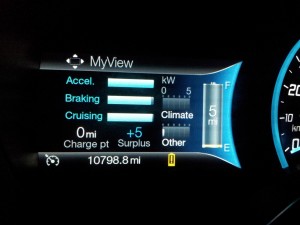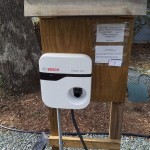Driving an EV longer distances requires one to do a little math, particularly if one is unsure a charging station can be found at the destination. I figured with my top range of about 75 miles, I would have more than enough to get there. The PlugShare app showed a ChargePoint charging station in the parking deck across from the hospital, so I figured I would be good to go.
I drove it in the Kia the first night and spent a little time beforehand walking around the parking decks in search of the charger. Walking through all three decks, checking every corner, I failed to find any charger. On the PlugShare app, no one had ever checked in at this station. The only thing worse than not knowing where a charger is is thinking that you know where it is and it not being there!
I drove the Focus there the second night, knowing there was no charger but thinking I might get lucky and find a regular outlet with which to charge. To my disbelief, there was no conduit anywhere to be found in the parking deck save the row right next to the attendant booth and handicap parking. No way could I plug in and use that. Instead of taking home a full charge and cruising at highway speeds, I wound up limping home, driving well below the speed limit and hoping I wasn’t too much of a hazard. It turns out I made it out and back successfully on one charge: a 66-mile round trip. Whew!
The second trip out there I did things a little differently. I didn’t have enough in reserve and, thinking I might economize by taking Highway 54 rather than I-40, I peeled off the interstate at Apex. While it’s true that driving around 50 MPH is more economical than driving 70 on I-40, the backroads are also not as direct. I wound up driving more miles and losing energy with frequent stops at traffic lights. I arrived home on electric fumes, with only 5 miles left on the batteries. Lesson learned: wind drag at highway speeds might sap an EV’s economy but a direct course beats a roundabout one.
Friday night was the night I got wise. An EV owner has a rental business about a 5 minute walk behind the hospital parking decks. I found his charging station on PlugShare and was delighted to be able to not only fully charge my car but to avoid paying for parking at the deck. My trip home was at highway speeds with 22 miles to spare. Success!
Knowing I could get home either way, I decided to economize on Saturday. My trip out to Chapel Hill was done around 60 MPH. To my surprise, I was not alone at driving this speed. I didn’t stand out at all. My efforts paid off when I rolled up to the hospital deck with 50 miles of capacity left (down from 80 at the start). This allowed me to get home worry-free at highway speeds again. Saving on the front end of the trip gave me more flexibility for the return trip.
A big help with the EV on longer trips is the navigation system. The system asks if you’ll be charging at your destination. By answering yes, the car computes the range you will have left once you get there (displayed as the “surplus”). This lets you employ your range-saving tricks as you go, knowing what you’ll have left once you get there. As long as your surplus value remains positive, you know you’ll be able to get back home.
Bottom line? Longer-range EV trips can be done. I’ve gained confidence in how to stretch my EV’s range, and how to calculate my odds of returning without an emergency charge. It opens up the Triangle for exploring in my electric vehicle. In a future post I’ll tell you what I’ve learned about the Triangle and EVs. Happy driving!

